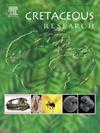First reports of a probable ankylosaurian (Thyreophora) trackway from the Jindong Formation (Cenomanian) of Goseong County, South Korea
IF 1.7
3区 地球科学
Q1 GEOLOGY
引用次数: 0
Abstract
A quadrupedal trackway (GS-BHG 2) reported from the Bonghwa-gol tracksite of the Upper Cretaceous Jindong Formation (Cenomanian) shows morphological differences from other dinosaur ichnotaxa from South Korea and other Asian countries. The trackway GS-BHG 2 is characterized by an elongated pes with three short, blunt, and straight digits and oval-to kidney-shaped manus without discernible digit traces showing low heteropody and wide trackway gauge. Based on its morphological characteristics and the temporal distribution of dinosaur fauna during the ‘mid’-Cretaceous, the trackmaker of GS-BHG 2 is tentatively assigned as an ankylosaurid dinosaur, and we refer this trackway as cf. Ruopodosaurus. Pes tracks of GS-BHG 2 show differential depth in their medial and lateral parts, implying that the pressure was focused on the medial part of the pedes during locomotion.
在韩国高城郡金洞组(Cenomanian)首次发现可能的甲龙(Thyreophora)足迹
在白垩统上白垩统金洞组(Cenomanian)奉花金足迹遗址发现的四足恐龙足迹(GS-BHG 2)与韩国和亚洲其他国家发现的恐龙化石在形态上存在差异。轨道GS-BHG 2的特点是细长的类型,有三个短,钝,直的手指和椭圆形至肾形的手,没有明显的手指痕迹,显示低异足和宽轨道轨距。根据GS-BHG 2脚印的形态特征和恐龙区系在“中”白垩纪的时间分布,初步确定GS-BHG 2脚印为甲龙,并将其命名为若opodosaurus。GS-BHG 2的足径内侧和外侧深度不同,说明运动时压力主要集中在足径内侧。
本文章由计算机程序翻译,如有差异,请以英文原文为准。
求助全文
约1分钟内获得全文
求助全文
来源期刊

Cretaceous Research
地学-地质学
CiteScore
4.10
自引率
19.00%
发文量
235
审稿时长
12 weeks
期刊介绍:
Cretaceous Research provides a forum for the rapid publication of research on all aspects of the Cretaceous Period, including its boundaries with the Jurassic and Palaeogene. Authoritative papers reporting detailed investigations of Cretaceous stratigraphy and palaeontology, studies of regional geology, and reviews of recently published books are complemented by short communications of significant new findings.
Papers submitted to Cretaceous Research should place the research in a broad context, with emphasis placed towards our better understanding of the Cretaceous, that are therefore of interest to the diverse, international readership of the journal. Full length papers that focus solely on a local theme or area will not be accepted for publication; authors of short communications are encouraged to discuss how their findings are of relevance to the Cretaceous on a broad scale.
Research Areas include:
• Regional geology
• Stratigraphy and palaeontology
• Palaeobiology
• Palaeobiogeography
• Palaeoceanography
• Palaeoclimatology
• Evolutionary Palaeoecology
• Geochronology
• Global events.
 求助内容:
求助内容: 应助结果提醒方式:
应助结果提醒方式:


